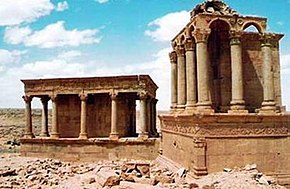Gerisa

Gerisa ruins
|
|
| Location | Libya |
|---|---|
| Region | Misrata District |
| Coordinates | 30°56′48″N 14°33′04″E / 30.946737°N 14.551069°ECoordinates: 30°56′48″N 14°33′04″E / 30.946737°N 14.551069°E |
Gerisa or "Gaerisa" was an ancient city of Roman Libya near the Limes Tripolitanus. It was called "Ghirza", a small village of 300 inhabitants on the pre-desert zone of Tripolitania.
Even if there was a small local settlement, it was only when Roman legionnaires arrived in Tripolitania that the city of Gerisa (called "Ghirza") was created and developed. Initially its population was mainly local berbers, but some Roman merchants settled there during late Augustus times.
The Limes Tripolitanus was expanded under emperors Hadrian and Septimius Severus, in particular under the legatus Quintus Anicius Faustus in 197-201 AD.
Anicius Faustus was appointed legatus of the Legio III Augusta and built several defensive forts of the Limes Tripolitanus in Tripolitania, among which Garbia and Golaia (Bu Ngem) in order to protect the province from the raids of nomadic tribes. He fulfilled his task quickly and successfully.
As a consequence the Roman city of Gaerisa, situated away from the coast and south of Leptis Magna, developed quickly in a rich agricultural area. Gerisa became a "boom town" after 200 AD, when the Roman emperor Septimius Severus (born in Leptis Magna) had organized in a better way the Limes Tripolitanus.
Former soldiers -mostly local Berbers, but even some legionaries from the Italian peninsula- were settled in this area, and the arid land was developed. Dams and cisterns were built in the Wadi Ghirza (then not dry like today) to regulate the flash floods. These structures are still visible: there it is among the ruins of Gaerisa a temple, which may have been dedicated to the Berber semi-god "Gurzil", and the name of the town itself may even be related to his name.
The farmers produced cereals, figs, vines, olives, pulses, almonds, dates, and perhaps melons. Gaerisa consisted of some forty buildings, including six fortified farms (Centenaria). Two of them were really large. It was abandoned in the Middle Ages.
...
Wikipedia

